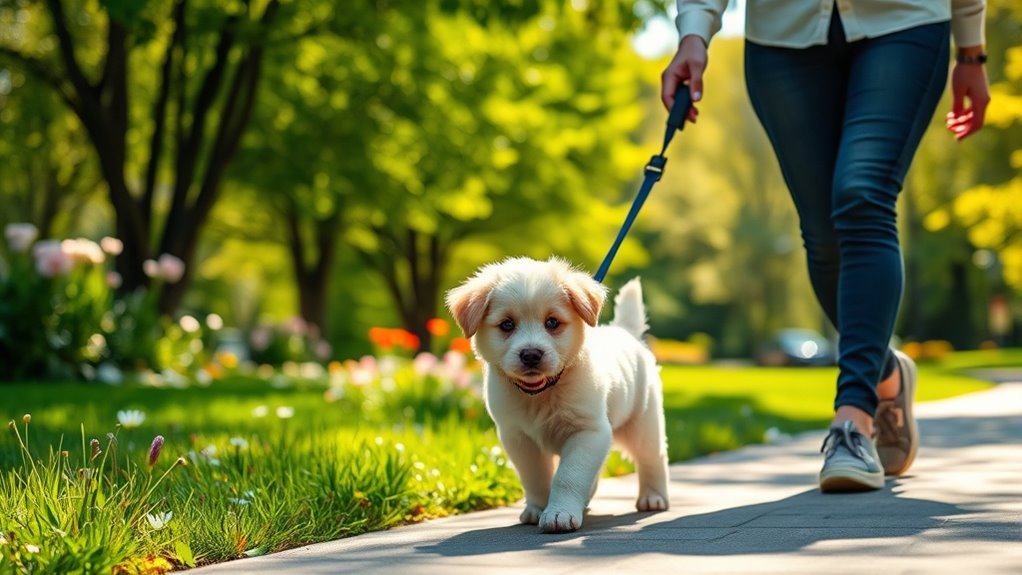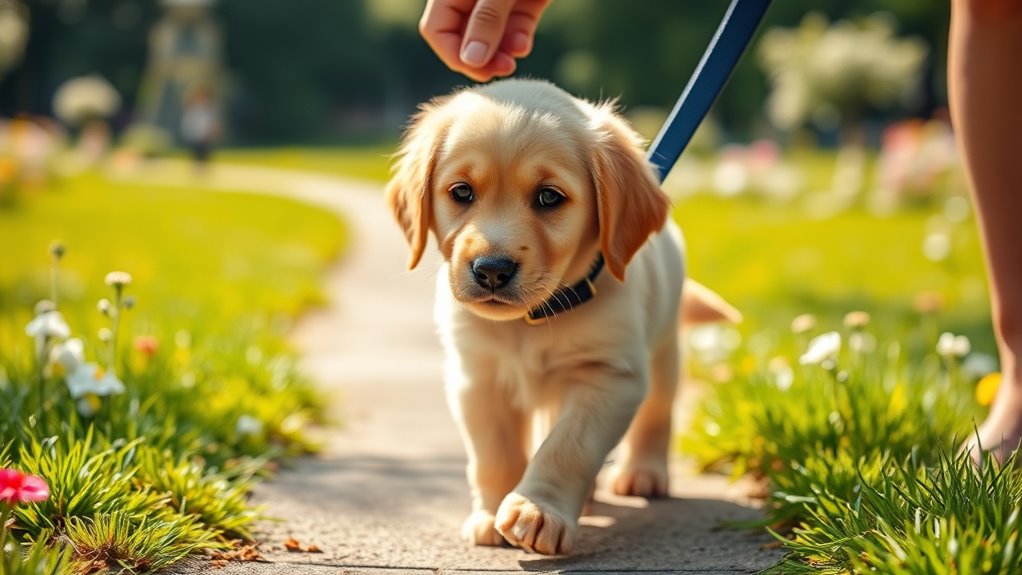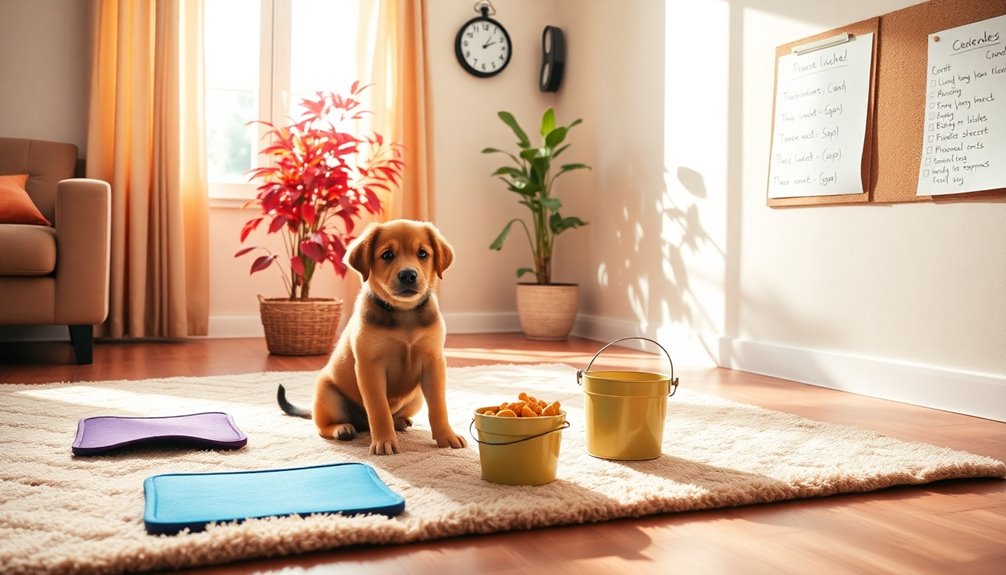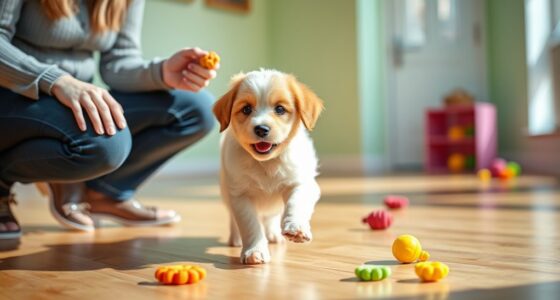To teach your puppy to walk politely on a leash, start with crate training to help them feel secure. Gradually introduce the leash, using treats and praise to create positive associations. Practice socialization in controlled environments to build confidence. Keep training sessions short, calm, and consistent, rewarding good behavior. Patience and understanding are key. For more tips on encouraging polite leash manners, explore the next steps to ensure your puppy’s success.
Key Takeaways
- Use positive reinforcement, treats, and praise to encourage calm, polite walking behaviors.
- Introduce the leash gradually in a quiet, familiar environment to build comfort and confidence.
- Keep training sessions short, consistent, and end on a positive note to reinforce good habits.
- Gently guide your puppy beside you, rewarding them for staying close without pulling.
- Ensure your puppy is crate-trained and socialized to reduce anxiety and promote confident leash manners.

Are you ready to teach your puppy how to walk politely on a leash? The journey begins with a solid foundation rooted in crate training and effective socialization techniques. Crate training helps your pup feel secure and creates a safe space where they can rest and learn boundaries. When your puppy is comfortable in their crate, it becomes easier to introduce leash training because they associate the crate with positive experiences. Use the crate consistently, and don’t forget to make it a welcoming environment by offering treats and praise. This approach builds trust and reduces anxiety, making it easier to progress to leash walking.
Once your puppy is comfortable in their crate, it’s time to focus on socialization techniques. Exposing your pup to different people, animals, sounds, and environments early on helps prevent fearfulness and aggression later. Well-socialized puppies tend to be more confident and calmer on walks, making leash training smoother. Take your puppy to safe, controlled locations where they can meet friendly people and other vaccinated dogs. Keep interactions positive, and reward calm behavior with treats and praise. This not only boosts their confidence but also teaches them that new experiences are enjoyable, which translates into better leash manners.
When introducing the leash, keep sessions short and positive. Let your puppy sniff and explore the leash while offering treats. Don’t pull or jerk; instead, gently encourage them to follow your lead. Use a collar or harness that fits comfortably, ensuring your pup feels secure. During these initial moments, keep the environment calm and free of distractions. As your puppy gets used to the leash, gradually introduce gentle guidance, rewarding them for walking beside you without pulling. Patience is key—if your pup pulls or gets distracted, calmly stop and wait for them to return to your side before continuing. This teaches them that staying close is rewarding and expected.
Consistency is essential. Practice leash walking in different settings and at different times to build confidence and reinforce good habits. Remember, socialization and crate training aren’t just about creating a happy, confident pup; they’re also the foundation for successful leash training. When your puppy feels secure and comfortable, they’re more receptive to learning new skills. Incorporate positive reinforcement techniques to motivate your pup and make training sessions enjoyable. Keep sessions upbeat and full of positive reinforcement, and always end on a good note. Before long, your puppy will walk politely on the leash, making walks enjoyable for both of you.
Frequently Asked Questions
How Long Does Leash Training Usually Take for Puppies?
Leash training for puppies typically takes a few weeks to a couple of months, depending on your pup’s personality and consistency. During this time, you’ll focus on puppy socialization and using the right leash training accessories like harnesses and leashes. Keep training sessions short and positive, gradually increasing duration. With patience and regular practice, your pup will learn to walk politely on a leash, making walks enjoyable for both of you.
Can Leash Training Prevent Future Behavioral Issues?
While leash training might seem just about control, it also promotes leash safety and puppy socialization, preventing future behavioral issues. When you teach your pup proper leash manners early, you foster confidence and good habits, reducing anxiety and aggression later. This balanced approach helps your pup navigate the world safely and politely, laying a foundation for well-behaved behavior as they grow, and making walks more enjoyable for both of you.
What if My Puppy Keeps Pulling on the Leash?
If your puppy keeps pulling on the leash, stay patient and practice good leash etiquette. Stop walking whenever they pull, then gently call them back and reward when they walk beside you. Consistent training helps build puppy patience and teaches them to walk politely. Use treats and praise to reinforce calm walking. Over time, your pup will learn to stay by your side without pulling, making walks more enjoyable for both of you.
Is Positive Reinforcement Better Than Correction Methods?
Studies show dogs trained with positive reinforcement are 60% more responsive than those corrected with punishment. You’ll find clicker training, a form of positive reinforcement, more effective and kinder. Punishment can cause fear or aggression, while positive methods build trust. So, yes, positive reinforcement is better because it encourages good behavior through rewards rather than fear, creating a happier, more confident pup on walks.
How Do I Train a Puppy With Leash Reactivity?
To train a puppy with leash reactivity, start with proper leash equipment choices like a harness and a short leash for control. Focus on puppy socialization by gradually exposing your pup to calm, controlled situations with other dogs and people. Use positive reinforcement to reward calm behavior and redirect attention when reactivity occurs. Consistent, patient training helps your puppy learn appropriate responses and builds confidence in new environments.
Conclusion
Think of leash training as planting a tiny seed that grows into a well-behaved, confident dog. With patience and consistency, you nurture this seedling, guiding it through gentle walks and positive reinforcement. Before you know it, your puppy blossoms into a loyal companion, enthusiastic to explore the world safely by your side. Remember, every step you take together shapes a lasting bond—your journey from sprout to sturdy oak.










